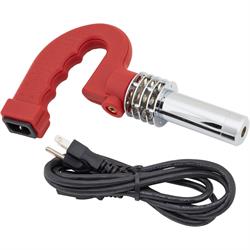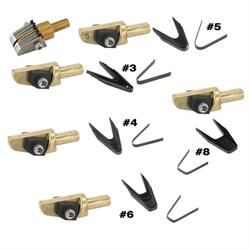Tire Grooving and Siping Tips
Supply chain disruptions and raw material shortages seem to have become the norm these days. In the wake of recent events within the rubber industry IMCA has issued a news release stating that due to nation-wide tire shortages, and to extend the life of current G-60 tires, IMCA now permits grooving of the G-60 tire effective June 23, 2021. Here we have compiled some tips for grooving and siping to assist you in getting the most out of your tires.
Hoosier Recommendations for IMCA G-60 Tires
Courtesy of Hoosier Racing Tire:
We would NOT recommend grooving brand new tires. New tires are already as aggressive as a tire will ever be, so grooving them will only reduce the block stiffness and INCREASE tire wear on a new tire without dramatically assisting performance.
We would recommend that after the 2nd night of racing on an IMCA G60, customers should recut the factory groove lines with a #3 width grooving blade. Cut each block individually for best results as the tread pattern lines do not match, and try to avoid creating small, unsupported areas in the tread blocks. We would also suggest placing a #1 groove across each of the blocks on the rear tires, and around on the front tires. This basically creates 2 smaller blocks and should increase movement for better traction or steering force.
As normal, we would still recommend 1 direction siping for the IMCA G60 tire. Siping around front tires creates steering force, across on rear tires creates traction force. You should be able to do less siping with a grooved tire, as the block structure is already reduced with the additional groove cuts.
Tire Grooving Iron Tool Prep
- Install the head and set the blade to the depth of cut needed before plugging in the tire groover
- Plug the grooving iron in and allow it to warm up for five to ten minutes before you start grooving; our tabletop tire grooving iron stand is suggested for warm up and cool down
- Position grooving irons with the cutting head facing up and the handle down in a vertical position while in use to minimize temperature transfer to the handle
- Monitor the temperature of the tool and unplug it as needed to regulate the temperature
- Grooving irons will reach operating temperature quickly due to the extreme heat created and will groove before reaching its max temperature
Prepare Your Tires Prior to Grooving
- Sanding the mold nubs off the tread before grooving or siping is suggested if the nubs are large; a tire grinder with a 60-grit sanding pad works well for this
- Most tires are easier to groove or sipe with the tire mounted and inflated to normal pressures; this is especially true with thin wall racing tires
- Complex tread designs can be marked out with a tire marking paint pen or paint stick
Tire Grooving Tips
- Grooves around the circumference of the tire will add side bite and help cool the tire
- Grooves across the tread will add forward bite and help warm up the tire
- Rear tire grooves and sipes across the tread typically work best when straight across the tread (90 degrees to the circumferential grooves)
- Front tire grooves and sipes across the tread typically work better at a slight angle and when viewed from the top of the right front tire the grooves will angle from right front to left rear
Photos courtesy of Hoosier Racing Tire
Tire Siping Tips
- Sipes have a similar effect as grooves and are primarily used to warm up the tire
- Sipes around the circumference do not provide much if any cooling effect since they are not open for air to flow through like grooves are
- 1/8-inch to 3/16-inch sipe depth works well for most tires.
- Adding more sipes which are closer together will increase the tire temperature and will add grip as long as the tire is not overheated
- If a tire is overheated and blisters the sipes need to be spaced further apart and possibly a shallower depth of cut should be used
- More sipes are typically used on front tires to help them heat up and less sipes on rear tires, especially the right rear







